Indian Runner Duck: The Upright Wonder of the Waterfowl World
The Indian Runner Duck is a striking bird—tall, graceful, and surprisingly nimble. Unlike its waddling cousins, it boasts a unique shape and purpose. This breed is known for its upright stance and impressive foraging abilities, making it a favorite among farmers, hobbyists, and backyard poultry enthusiasts. With a rich history and a lively personality, Indian Runner Ducks bring both charm and practicality to any setting.
Table of Contents
Scientific Classification
- Kingdom: Animalia
- Phylum: Chordata
- Class: Aves
- Order: Anseriformes
- Family: Anatidae
- Genus: Anas
- Species: Anas platyrhynchos domesticus
Description / Physical Description
The Indian Runner Duck is quite a sight, standing tall and straight like a feathered bowling pin. This breed really knows how to stand out! Unlike most domestic ducks that waddle around, these ducks glide smoothly and efficiently, almost as if they’re running. Their sleek bodies and long necks really add to their striking look.
Typically, adult ducks weigh between 3.5 to 5 pounds. Their legs are positioned further back compared to other breeds, giving them a distinctive upright posture and a quick, lively stride.
You’ll find Fawn and white Indian Runner Ducks, brown runners, and blue Indian Runner Ducks all sporting shiny, waterproof feathers in a stunning array of colors. The ducklings, including the white Indian Runner, fawn runner, and chocolate runner, are super easy to spot right after they hatch.
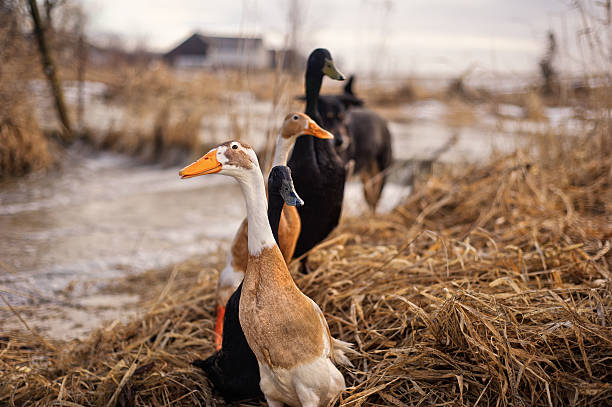
Range & Distribution
Indian Runner Ducks have a fascinating history that traces back to Southeast Asia, where they’ve been domesticated for centuries. These charming birds were first spotted in Indonesia, particularly on the islands of Bali, Java, and Lombok. They made their way to Europe in the 19th century and quickly gained popularity due to their impressive egg-laying abilities.
Nowadays, you can find Indian Runner Ducks gracing farms and estates all over the globe. They’ve settled in various places, including the United States, the United Kingdom, Australia, and across Europe.
Habitat
Indian Runner Ducks are quite adaptable when it comes to their living environments. These domestic ducks thrive in wetlands, rice fields, or lush meadows, but you’ll often spot them in backyards or on small farms. They require shelter to protect themselves from predators and harsh weather, along with access to clean water for bathing and plenty of space to forage.
Unlike some other duck species, they don’t need large lakes to be happy. Instead, they prefer shallow ponds or troughs where they can splash around, preen their feathers, and cool off.
Diet
Natural foragers, Indian Runner Ducks thrive on a varied diet. Their primary diet consists of:
- Insects
- Grubs
- Slugs
- Grass
- Aquatic plants
- Small crustaceans
They often chase trout Indian Runner Ducks in shallow waters. However, they rarely catch anything so fast.
In captivity, they usually eat commercial duck pellets. They also get grains, fresh veggies, and can access pasture. Providing access to oyster shell helps support eggshell production, especially in laying females.

Behaviour / Lifestyle
Indian Runner Ducks are lively, sociable, and have a gentle disposition. Unlike their mallard cousins, they aren’t great at flying and prefer to keep their feet on the ground. You’ll often see them moving together in tight-knit groups, running around in search of their next meal.
These ducks are active during the day and spend a lot of time foraging. They’re generally quieter than other duck breeds, with soft quacks that are unlikely to disturb the neighbors.
It’s also essential to understand the dynamics between male and female runner ducks, especially when they’re in a group. Males tend to have a soft, raspy voice, while females are more vocal, quacking loudly and frequently.
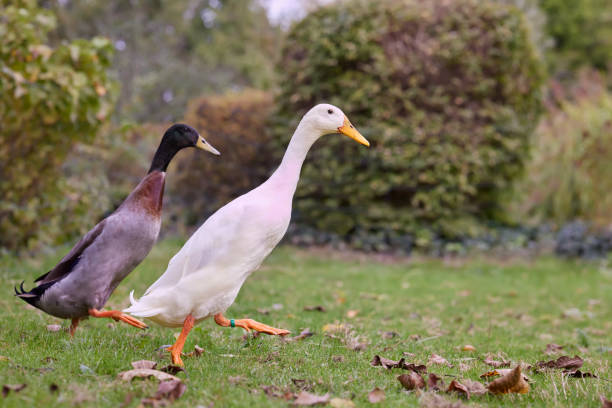
Lifespan
With the right care, Indian Runner Ducks can live anywhere from 8 to 12 years. Their lifespan can vary based on several factors, including genetics, diet, environment, and the level of veterinary care they receive.
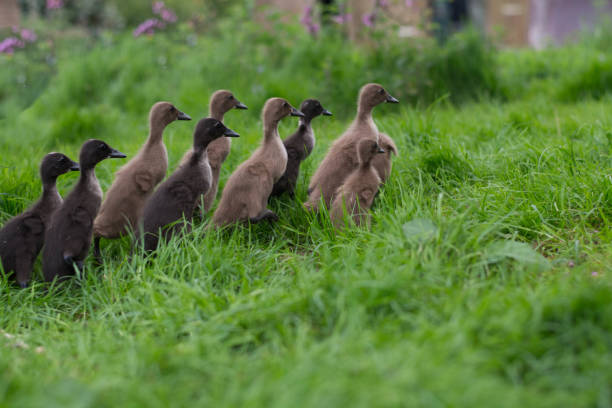
Adaptations
Indian Runner Ducks have adapted remarkably well to both wild and domestic environments. Their most notable adaptations include:
- Upright Stature: Enhances ground visibility for efficient foraging
- Efficient Gait: Allows rapid movement over large areas without flying
- Waterproof Plumage: Essential for preening and thermoregulation
- Hardy Digestive System: Processes a wide variety of vegetation and invertebrates
These traits make them perfect for pest management on farms and in gardens.
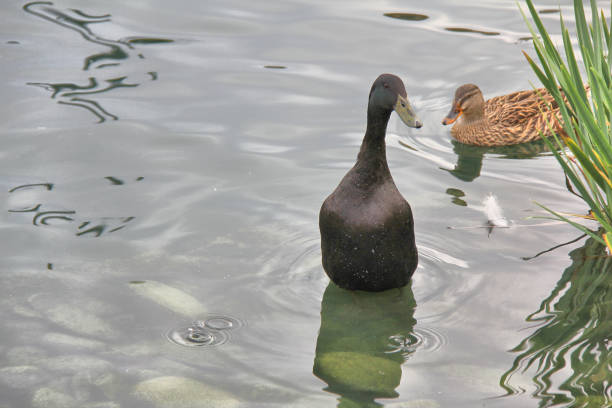
Mating & Reproduction / Reproduction & Lifecycle
Indian Runner Ducks form seasonal pair bonds. Breeding usually starts in early spring. In warm areas, egg production can happen all year.
Females start laying eggs at about 4 to 5 months old. Indian Runner Ducks start laying eggs when they are about 5 to 6 months old. They are prolific layers and can produce 250–300 eggs each year.
Egg colors vary depending on the variety:
- Black runner duck eggs and blue runner duck eggs are especially prized for their beauty.
Incubation lasts approximately 28 days. Ducklings are precocial, hatching fully feathered and mobile. To care for Indian runner ducklings, keep them warm and dry. Feed them a starter feed rich in nutrients and high in niacin for strong bones.
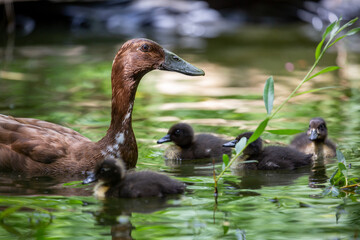
Predators
Indian Runner Ducks face numerous natural threats, including:
- Foxes
- Raccoons
- Birds of prey (hawks, eagles)
- Snakes
- Domestic dogs
Secure nighttime housing and vigilant supervision help prevent losses, especially in free-range setups.
Conservation Status
Indian Runner Ducks are not considered at risk. They are a popular and populous domestic duck breed worldwide. A network of fans and Indian Runner Duck breeders keeps them thriving.
Dedicated organizations and breeders still focus on keeping breed purity and genetic diversity.
Interesting Facts
- Their upright posture is a result of selective breeding rather than a deformity.
- Unlike most ducks, they rarely sit unless nesting or sleeping.
- A flock of Indian Runners can effectively clear a garden of slugs in a single day.
- Runner ducks have inspired animated characters due to their comical, endearing stride.
- They do not require ponds to swim in and can thrive with just a tub or shallow pool.

As Pets
Indian Runner Ducks make excellent pets for the right owners. They are:
- Affectionate and curious
- Low-maintenance compared to other poultry
- Natural pest controllers
Raising Indian Runner Ducks requires attention to housing, predator-proofing, and dietary needs. Daily access to clean water and shelter is essential.
Families and schools love them. Their interactive nature and quirky antics make them a hit.
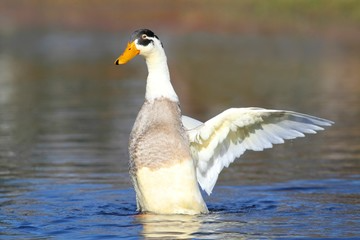
Classification of Species
The Indian Runner Duck isn’t just any wild species; it’s actually a domesticated subspecies of the mallard (Anas platyrhynchos). Over time, these ducks have been selectively bred for their unique posture and productivity, leading to the distinct lineage we see today.
Subspecies
Indian Runner Ducks are not classified into subspecies in the traditional taxonomic sense.
Colours
A dazzling spectrum of color morphs exists within the Indian Runner lineage:
- Fawn and White Indian Runner Ducks: Soft beige body with white undercarriage and neck.
- Blue Indian Runner Duck: Slate-gray plumage with subtle steel-blue tones.
- Brown Runner Ducks: Earthy and understated, often with green iridescence in males.
- Chocolate Runner Duckling: Deep brown fuzz that matures into rich cocoa plumage.
- White Indian Runner Ducklings: They are pure white from hatchling to adult. Their bills are often pinkish.
- Trout Runner Ducks: Spotted or speckled in a mix of grays and tans, resembling wild trout patterns.
- Fawn Runner Ducklings: Creamy tan with lighter highlights, known for their gentle disposition.
These color variations look great and help breeders and enthusiasts keep genetic diversity.Indian Runner Ducks are not only fun to watch but also hardworking, graceful, and very lovable. Ducks can be kept for eggs, company, or pest control. These amazing birds keep surprising their owners and change how we see ducks.


